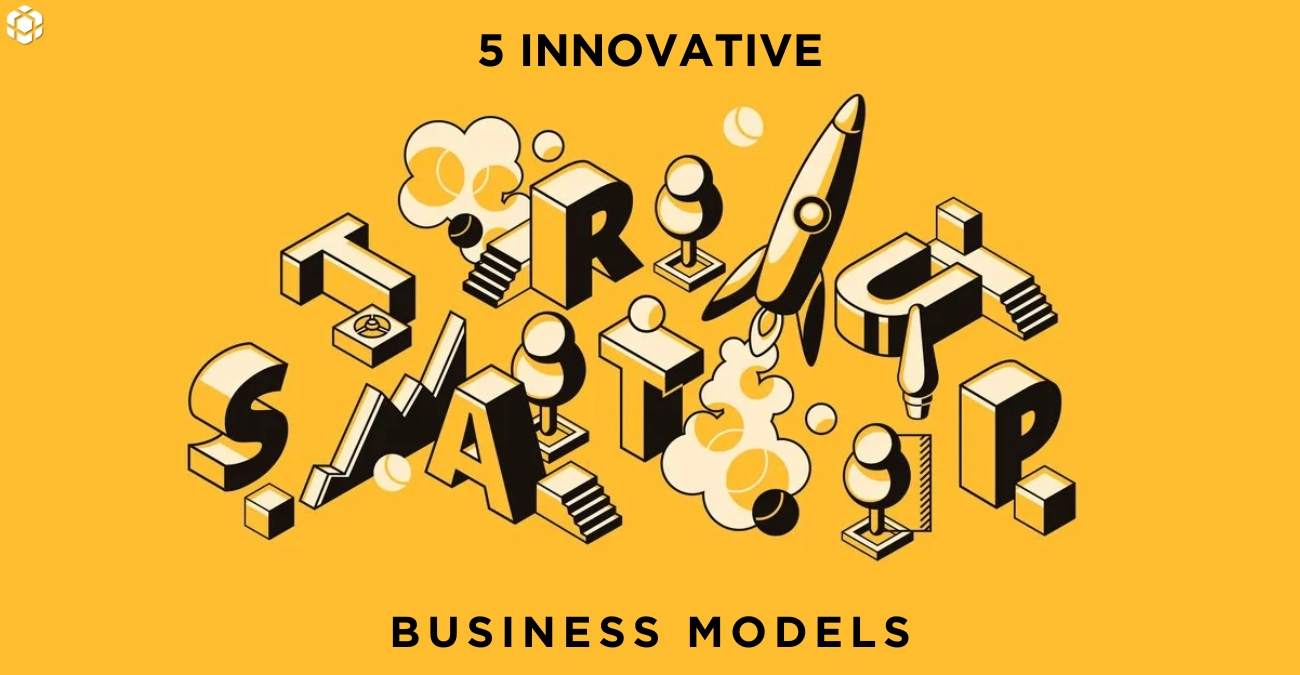
Are you thinking about beginning your own business journey but finding it challenging to come up with ideas? Relax, it’s a drawn-out process that nearly all new business owners experience. Selecting an appropriate business model is just one of many decisions you must make during the most difficult initial phase.
In this era, there are more than enough business models, each with its own pros and cons. The kind of business and the needs of the customers will determine which model you choose, among other things.
Check out these five creative business models for your startup if you are having trouble coming up with profitable, tried-and-true business models.
What is a business model?
A business model refers to ways in which the business earns money. Although there is some distinction between a business model and a revenue model, the two terms are used interchangeably quite often.
Business models consist of detailed plans and describe a framework that outlines how a company creates, delivers, and captures value. It describes the fundamental aspects of how a business operates, generates revenue, and sustains itself. Components that form part of any business model include value proposition, revenue streams, cost structure, key partnerships and resources, etc.
In the end, it all comes down to how well you conduct your business, which can only be defined by a reliable and efficient business model, so its value should never be underestimated. If we take a closer look, we’ll see that many companies sell common goods but prosper because of how they market their brands, which are all governed by the business model.
To get a better understanding of the different types of business models for startups, continue reading till the end.
Types of business models for startups
There are many different types of businesses in the world today, and they all successfully use some strategy to run their operations. The methods that are effective for most companies are then referred to as business models, which apply to new startups looking to enter the market.
There are different types of business models for startups, such as;
- Freemium business model (Freemium = Free + Premium)
- Subscription business model
- Aggregator business models
- Pay-as-you-go business model
- Fee-for-service (FFS) business model
- EdTech business model
- Lock-in business model
- API licensing business model
- Open-source business model
Five business models to consider for your startup
If you are looking for innovative models that fit your business idea, then make sure to consider the ones mentioned here:
SaaS Based Model
Software as a Service-based business model includes a company subscribing to receive services of fully functional software from another company to utilize in their business operations. The selling company, which is typically an IT company, benefits from sales of the products for which it offers ongoing technical support and maintenance.
The model’s scalable nature allows for rapid deployment and scaling of services according to user demand while maintaining cost efficiency. SaaS businesses also foster strategic partnerships, integrating with complementary services or collaborating with cloud infrastructure providers to optimize service delivery.
Because SaaS offers so many business-handling conveniences, including lower upfront costs, no maintenance requirements, software availability across all departments, and much more, many companies are now making SaaS a part of their businesses. Therefore, startups that provide software to other companies tend to earn a good profit.
Transactional Model
Another business model that is popular among new startups is the transactional model. It thrives on acting as an intermediary between buyers and sellers, bringing value to the transaction and making money in the process. At its core, this model works by streamlining and optimizing exchanges between parties, often across various industries and sectors.
The transaction fees levied on the buyer, seller, or both parties involved in the exchange are the main source of income in the transactional model. These fees, which are usually set as a fixed fee or as a percentage of the transaction’s value, provide a steady source of income for companies using this business model.
The model is popular among many organizations including real-estate agencies, PR agencies, event companies, etc. Recruiting agencies also excel in matching job seekers with employers, earning fees for successful job placements.
The transactional model is very flexible and scalable and offers numerous opportunities for expansion. In general, especially in sectors with high transaction volumes, the transactional business model can be a very successful means of facilitating transactions and making money.
Advertisement-based Model
Though it has been around for decades, the advertisement business model has only recently been fully employed in the digital age. Newspapers, magazines, and radios have been replaced by digital mediums which make it easier to advertise and market business.
The revenue generation strategy of the advertising business model is based on the sale of advertising. Typically, a company makes money by selling access to its audience after first building an audience through content creation or interaction.
The model is a mainstay of many online businesses, from search engines like Google to eCommerce sites like Amazon and all in between.
While some speculate on its potential obsolescence, the advertising business model remains a pivotal strategy for the future. Once in place, this model allows businesses to generate revenue without directly selling a product or service. Additionally, advertisers are often willing to invest more in accessing a focused and actively engaged audience.
Freemium Model
The freemium model has emerged as a widely favored strategy for startups, seamlessly blending free and premium services through a tiered structure. In this model, the free service acts as an entry point, providing users with essential functionalities. Meanwhile, the premium tier offers an elevated experience with additional features and perks.
Suppose your startup focuses on productivity software aimed at professionals. You might introduce a freemium model by offering a free version with core features like task management, basic collaboration tools, and a limited document storage capacity.
In contrast, the premium tier could present an array of advanced functionalities, including features such as advanced project analytics, integrations with popular third-party apps, increased storage space, priority customer support, and the ability to create custom workflows tailored to the user’s needs.
The free tier should offer sufficient value to entice users, serving as a taste test of your service’s capabilities. Simultaneously, the premium tier needs to be substantially more compelling to your core audience and because of the added value it provides, users are encouraged to move from the free tier to the premium option.
With the freemium model, the strategy revolves around enticing customers with the accessibility of the free tier. It allows users to explore your service, fostering familiarity before making the leap to the premium level. The key lies in creating a seamless transition where users naturally gravitate towards the premium tier for an enhanced experience, driven by the desire for the added benefits and features it offers.
A few companies that utilize the freemium model include Spotify, YouTube, and LinkedIn. The model is excellent for new startups that want to introduce their unique services in the market.
Marketplace Platforms
Marketplaces provide a unique gateway to connect buyers with sellers. These platforms hold a variety of products that are showcased, bought, and sold through the market. It leverages transactions, but unlike the transactional model, marketplaces accommodate numerous participants engaging in various exchanges.
The breadth of marketplaces spans industries like e-commerce, travel, services, finance, collectibles, and automotive, which shows the diverse range of transactions facilitated by these platforms. One of the pioneers of this business model is Amazon, which establishes a marketplace for people looking to buy products at a lower price and those looking to sell them. Other famous marketplaces include;
- Alibaba
- eBay
- Upwork
- OpenSea
When executed adeptly, a marketplace model can yield remarkable success. Marketplaces offer customers an extensive array of products or services, fostering immediate access to unparalleled offerings thereby stimulating economic growth.
Startups typically choose this model due to its convenience in facilitating the establishment of a relationship between the buyer and seller. It effectively removes the requirement for a physical location and enables you to manage the business remotely.
How to choose the best business model for your startup?
Choosing a reliable business model is a lengthy process that involves various steps, including the ones listed below:
Analyze the market potential and rival companies
Before choosing the model you want to use for your company, it is important to learn about the market potential that currently surrounds your brand and the positions of your competitors.
The process involves conducting a thorough analysis of rival companies to comprehend their strategies, revenue streams, and customer engagement tactics and identifying gaps in the market that competitors might be overlooking or areas where they’re excelling, which could inspire innovative approaches for your own business model.
Assess your consumer market
Understanding your consumer market is also a significant approach that allows you to focus on customer priorities. It begins with comprehensive research to grasp the nuances of your potential customer base. It involves analyzing demographic factors such as age, gender, location, and income levels to identify the target audience.
Research your customer’s needs
Once you have a clear idea about your consumer market, you can start interacting with the customer base by conducting interviews and surveys to gather insights about their desires, pain points, and expectations.
Their input helps highlight areas that are not given enough attention. After that, you can go ahead and create a strategy to satisfy their requirements, which might also help you stand out from the competition.
Try out different business models to see what works
Business models discovered through experimentation are generally the best ones. Limited-scale launches or pilot programs can offer practical insights into consumer reactions and market viability. Under each model, carefully gather and examine revenue generation, acquisition costs, and customer engagement data.
It’s imperative to take an iterative approach and modify and refine your business model based on the data collected. It’s about identifying the model that speaks to your target market and supports sustainability and your company’s objectives.
Conclusion
The choice of an appropriate revenue business model is ultimately crucial to the success of a startup. Making this decision requires a thorough analysis of the particular dynamics of your company. Moreover, you can follow through with tried and tested business models or hop on to follow new and innovative ideas!



